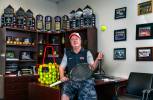Wheelchair athletes refuel competitive spirit on tennis courts
The courts at the Darling Tennis Center, 7901 W. Washington Ave., usually are filled with the rhythmic “thunk” of tennis balls being hit. However on Nov. 23, there was only the sound of raindrops.
That Saturday was to have been day one of the fourth edition of the Las Vegas Xenergy Open for Wheelchair Tennis, a two-day event. Instead, contenders used it as a chance to reconnect as they waited for the rain to cease.
Frank Vandekerckhove, 47, a Las Vegas resident and an amputee due to illness, organized the event. He said most of the participants were already tennis players when they went into a wheelchair.
“We all have that drive to play. The only difference is that we are in wheelchairs,” he said. “Wheelchair tennis is a small community. A lot of us know each other, so it’s like a get-together of tennis players but friends, too.”
This year’s tournament saw roughly 40 players from age 14 into their 60s. Only two— Vandekerckhove and Bill Willhite — were Las Vegas residents. Willhite, 40, has one leg that is shorter than the other and wears an elevated shoe.
The tournaments are held in various cities in the Western region, usually once a year. This day, players were from Nevada, California, Oregon, Idaho, Colorado and Virginia. Melissa McGuire, 29, came from the Denver area and has been playing wheelchair tennis since 2007.
“I like being around people who live with the challenges day-to-day of being (in a wheelchair),” she said. “They know what being disabled means.”
McGuire had just turned 17 and was celebrating her high school graduation with a friend when a drunken driver blew through an intersection at 65 mph. McGuire was in a coma for four weeks. Her friend was killed instantly.
Basketball was McGuire’s sport of choice in high school, and she said she’d never tried tennis. That’s good, she said, as learning tennis meant she had nothing to compare it to from her life before the accident.
“Exercise in general is something you can enjoy,” McGuire said. “It gives you something to focus on, something to be passionate about, even though it’s (done) differently.”
Another player was Akiji Koiwalakai, 42. Originally from Hawaii, he was injured in a car accident in 2000 in Boulder, Colo., and broke his back in three places. His injuries led doctors to find a brain tumor that resulted in near-complete hearing loss. A hearing aid helps, but mostly he said he reads lips.
When he plays tennis, he must first teach his opponent the hand signals he uses to indicate the score or a “let” — when the ball hits outside regulation lines.
When he first went into a wheelchair, he said he “had a really hard bout of depression because I didn’t just play tennis, I was a teaching pro with the United States Tennis Association.”
That job had taken him to England, Australia, Japan and other locations. With all that snatched away, he said he fell into a deep depression and attempted suicide three times. He found comfort in food, and his weight ballooned to 480 pounds.
“To save my life, I had gastric bypass,” Koiwalakai said, adding that he now weighs 180. “I went back to playing tennis again. I had never heard of wheelchair tennis before. Now, it’s my whole life.”
In 2007, he won the U.S. Open in his division. In 2010, he played in the U.S. Open wheelchair division.
Aimee Wenske, marketing coordinator with Xyience, said the energy drink company is mostly associated with the Ultimate Fighting Championship but wanted to expand to other sports.
“They don’t talk about being handicapped,” Wenske said of the wheelchair tennis players. “When they’re there, they’re just there to play tennis.”
The tournament came with its own set of rules. Wheelchairs are not known for their speed, so players are allowed two bounces before returning the ball. The first bounce must be inside the lines. Then second can be outside. Games are coed.
Another difference? There is usually no audience. In a “let’s play fair” policy, players call their own line shots, and questionable calls are not challenged.
“So, you’re competitive, but you get along,” Vandekerckhove said. “Afterwards, you all get together and go to dinner together or something like that. It’s almost like friends having a reunion.”
There are four divisions — Open, A, B and C. Open is for top players, and C is for beginners.
Jonathan Foster, senior inclusion recreation specialist for the city of Las Vegas, directs the Paralympic Sports Club Las Vegas, part of the city’s Adaptive Recreation Division. It has 11 tennis wheelchairs, which cost $2,500 each.
“It’s hard for a lot of people to afford those on their own, and insurance won’t cover them usually,” Foster said.
This is the fourth time in five years that Las Vegas has hosted the event. It was not held last year, as Vandekerckhove had surgery and cancer treatments and could not organize it. He did not count on the 2013 event seeing rain.
The first day was a bust with the constant battering from dark clouds, but Sunday’s skies were blue. Players hit the courts for an abbreviated tournament that scratched singles play.
The A doubles trophy was won by Seth Ritchey and Kriss Burwell from Colorado. The B doubles bracket was won by Jessica Sporte from Colorado and Carl Backstrom from Oregon.
Koiwalakai said he was impressed with the Darling complex.
“Love this facility; it’s very professional,” he said. “I’ve seen facilities all over, and this is one of the tops.”
Contact Summerlin/Summerlin South View reporter Jan Hogan at jhogan@viewnews.com or 702-387-2949.































